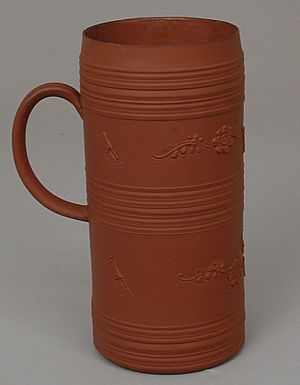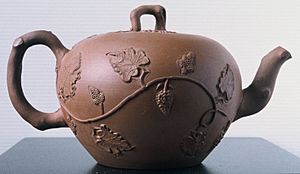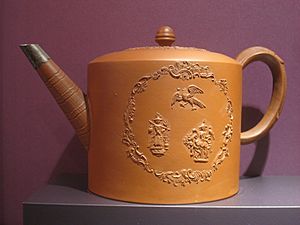Elers brothers facts for kids
Quick facts for kids
John Philip Elers
|
|
|---|---|
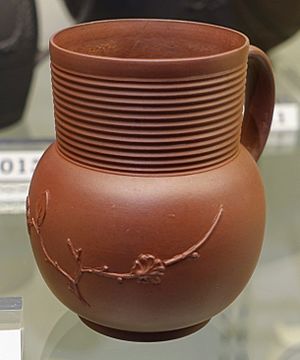
Mug, 1693-98, with Chinese-style prunus-blossom sprigging
|
|
| Born | 7 September 1664 |
| Died | 1738 |
| Nationality | British |
| Occupation | Potter |
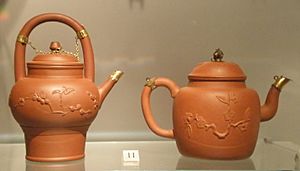
John Philip Elers (born September 7, 1664 – died 1738) and his brother David Elers were skilled silversmiths from the Netherlands. They moved to England in the 1680s and became famous potters.
The Elers brothers were very important in English pottery. They brought a special type of pottery called redware or unglazed stoneware to Staffordshire pottery. Many people believe they made the first "fine pottery" in North Staffordshire.
Even though their own pottery business didn't make a lot of money, they greatly influenced other potters. The pottery industry grew very quickly in the 1700s because of their ideas. It can be hard to tell their pottery apart from others who copied their style. These copies are often called "Elers type" or "style of Elers."
Contents
Becoming Potters
After moving to London, David Elers worked as a silversmith in 1686. By about 1690, both brothers were making stoneware in Fulham.
They found a special red clay in Bradwell, Staffordshire. This clay was perfect for making red pottery that looked like Yixing ware. Yixing ware was a famous Chinese red pottery imported into England. Some experts even said the Elers' clay was "even finer" than the clay used in China.
Around 1690, John Philip Elers set up a factory in a quiet spot near Burslem. Their finished pottery was stored about a mile away in Dimsdale. People said the buildings were connected by a special tube for talking! David Elers sold the pottery in London at his shop.
Their Special Pottery
The Elers brothers were known for their red, unglazed pottery. They mostly made teapots. These teapots often had raised designs, called sprigged ornament, in Chinese styles.
Like older Dutch stoneware, their teapots were heavily influenced by Chinese Yixing ware. Yixing ware was also unglazed stoneware, mostly used for tea. The shapes of their pottery also sometimes looked like European silver items. Some pieces even had fake Chinese writing, like the teapot in the Victoria & Albert Museum.
How They Made Pottery
Today, we know the Elers brothers used a method called slipcasting for all their pottery. This means they poured liquid clay into molds. Even for round shapes that could have been made on a pottery wheel, they used slipcasting.
This method made their pottery more expensive to produce and sell. However, it was an important new way of making pottery. They probably learned this technique from making pewter objects, which are also made by casting.
Years later, the famous potter Josiah Wedgwood wrote a letter about the Elers brothers. He mentioned they made pottery "by casting it in plaster moulds and turning it upon the outside by lathes." This shows how advanced their methods were for their time.
Challenges and Secrets
A writer named Simeon Shaw wrote about the Elers brothers in 1829. He said they kept their pottery-making methods very secret. Shaw wrote that they hired the "stupidest workmen" they could find. They even hired someone who was an "idiot" to turn the pottery wheel.
According to the story, two other potters, Josiah Twyford and John Astbury, discovered their secret. Astbury supposedly pretended to be foolish to learn their methods.
More simply, the Elers brothers faced legal problems from John Dwight. Dwight also made stoneware and had a special right to be the only one making it. The Elers brothers settled with Dwight by getting a license to make pottery until 1698.
John Philip Elers stopped his work in Bradwell in 1698. He had also been a farmer there. However, their pottery works in Vauxhall continued until both brothers faced financial difficulties in 1700.
About John Philip Elers
John Philip Elers was born in Utrecht. His father, Martin Elers, was German and lived in Amsterdam. John Philip had a sister who married Sir William Phipps. He also had his brother, David. Their uncle sold ceramics in London, and their father was involved in that business too.
John Philip and David Elers likely learned some technical skills in Cologne. They are thought to have moved to England in the 1680s.
After leaving Bradwell, John Philip Elers worked with a glass factory in Chelsea. There, he helped make soft-paste porcelain. Later, he moved to Dublin, where he opened a shop selling glass and china.
Elers married Miss Banks. They had a son named Paul Elers. Paul became a lawyer and married Mary Hungerford. Among their children was Maria, who married Richard Lovell Edgeworth. Maria was the mother of the famous novelist Maria Edgeworth.
A portrait of John Philip Elers was made by Josiah Wedgwood. There are also small portraits of Paul Elers and his wife.


